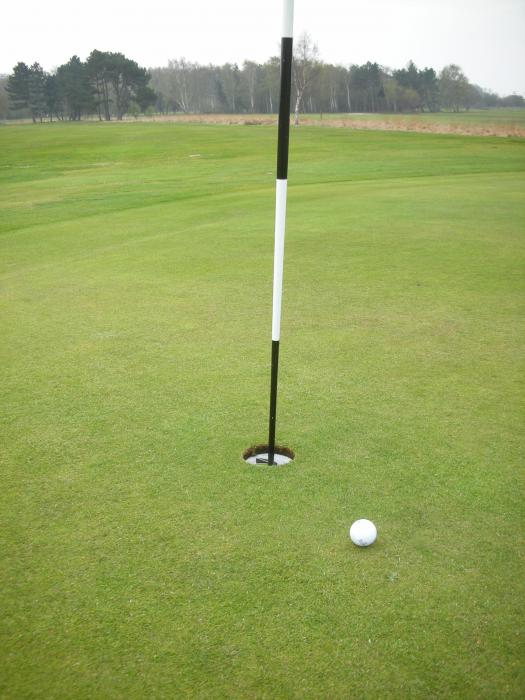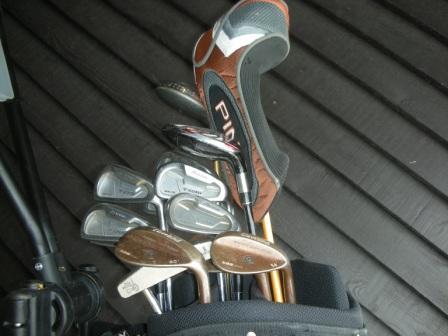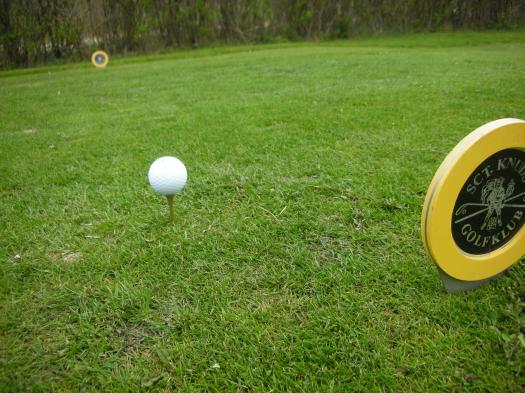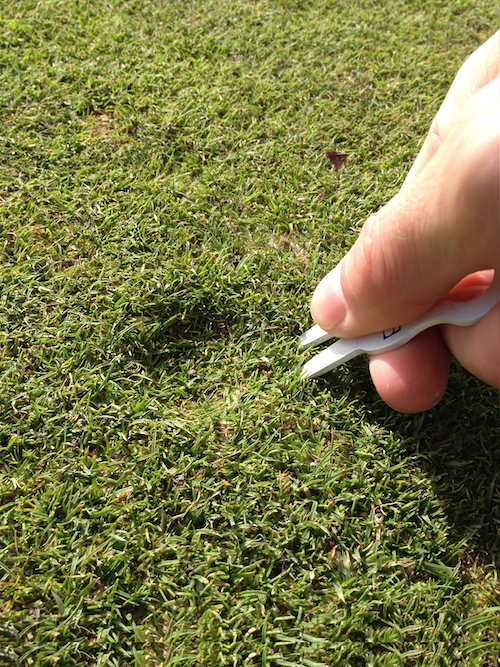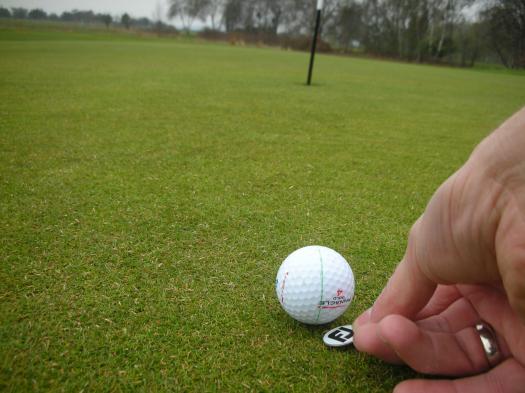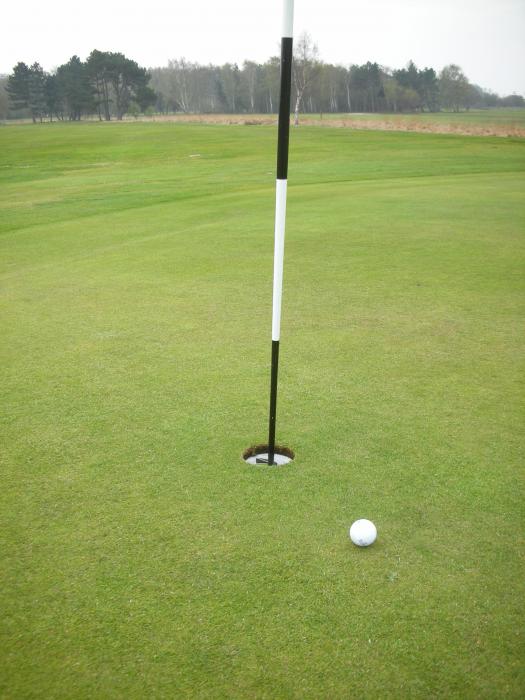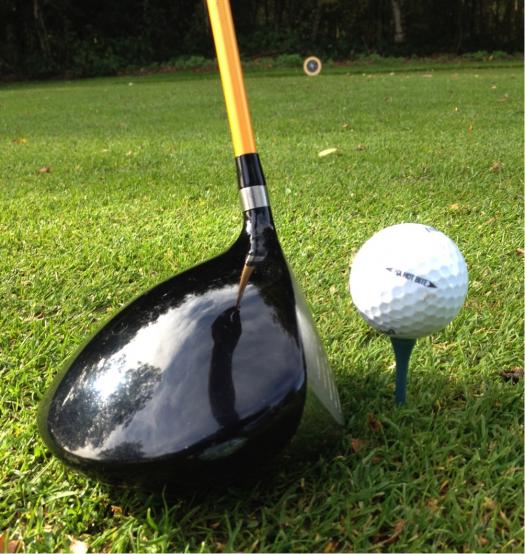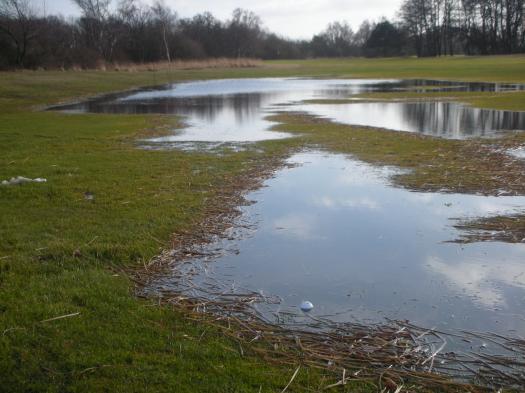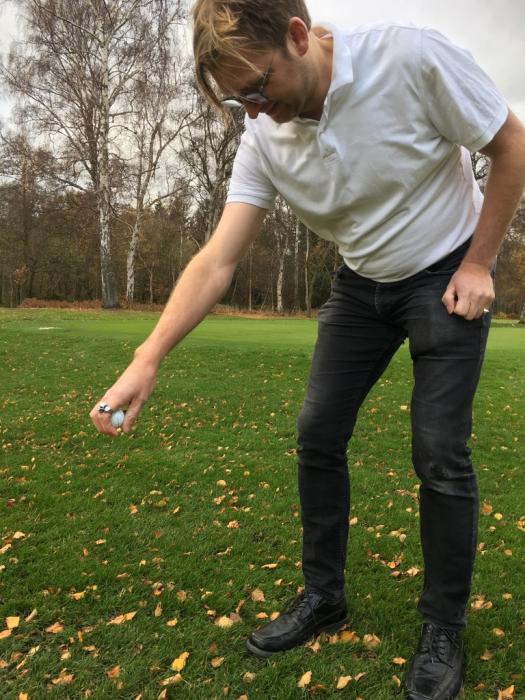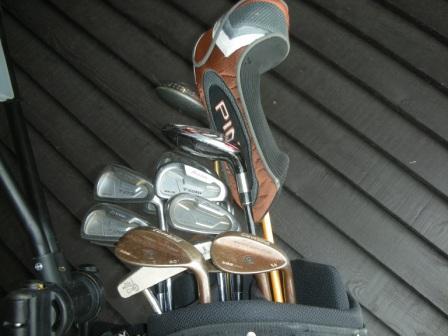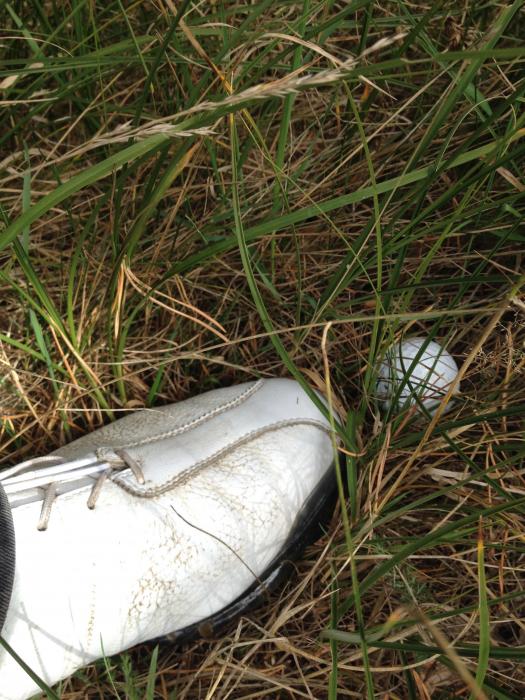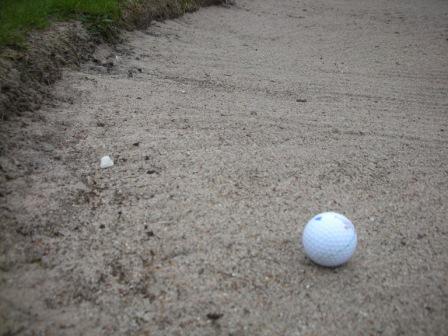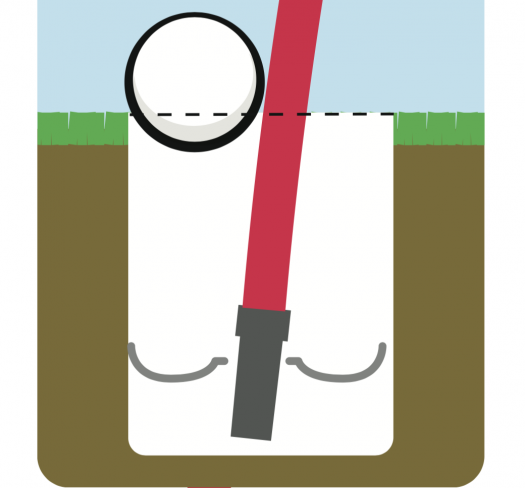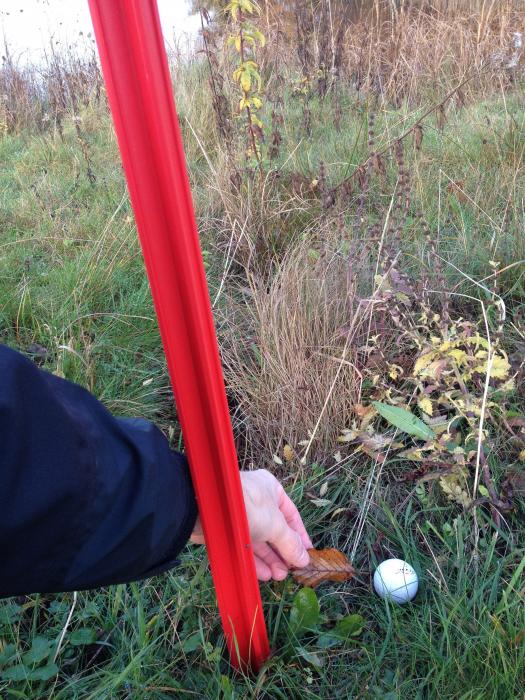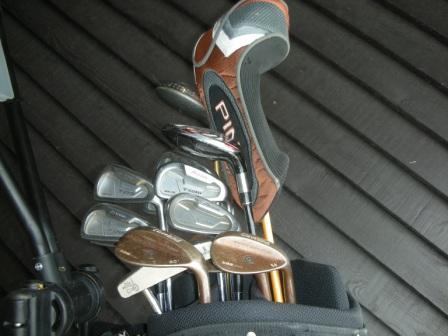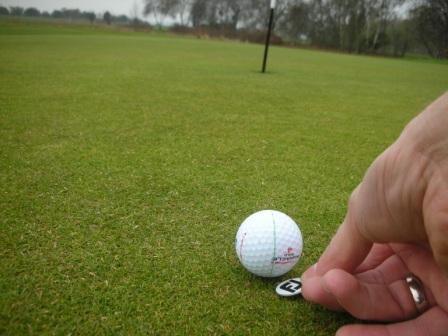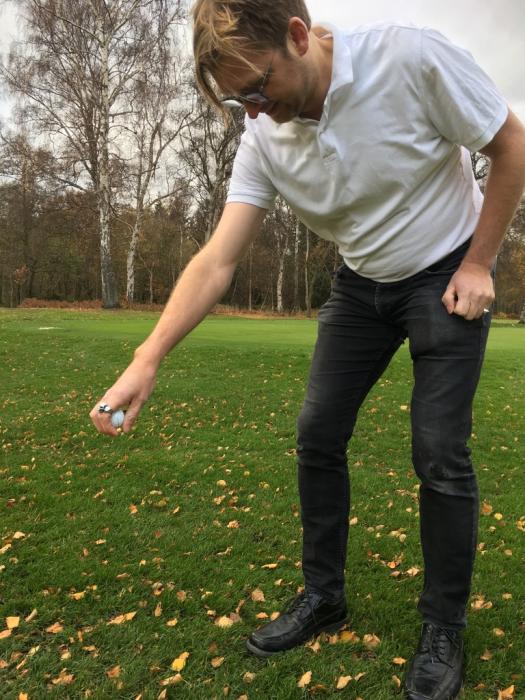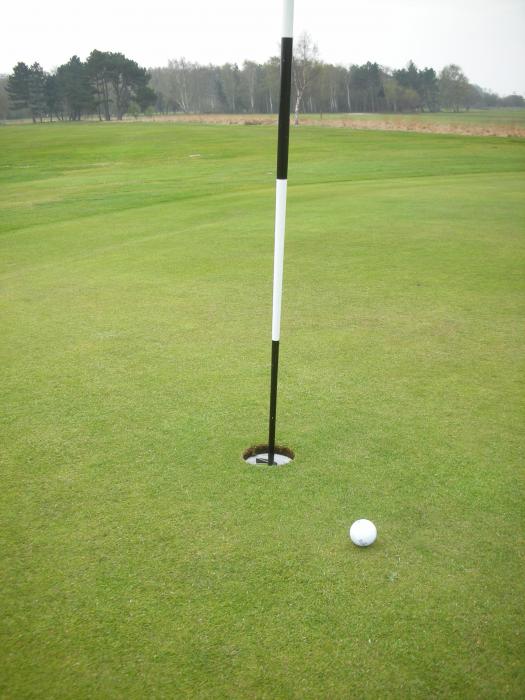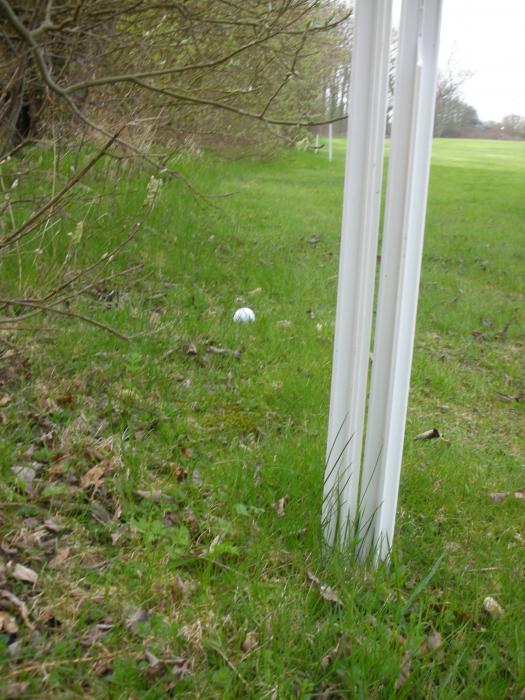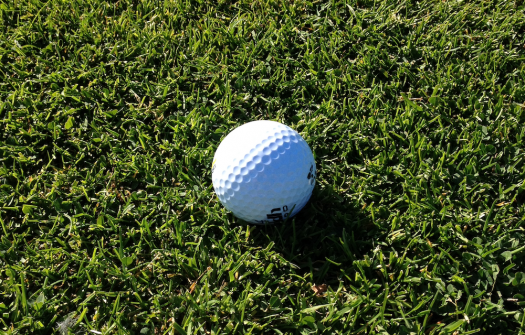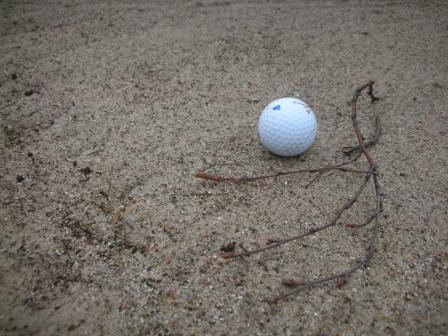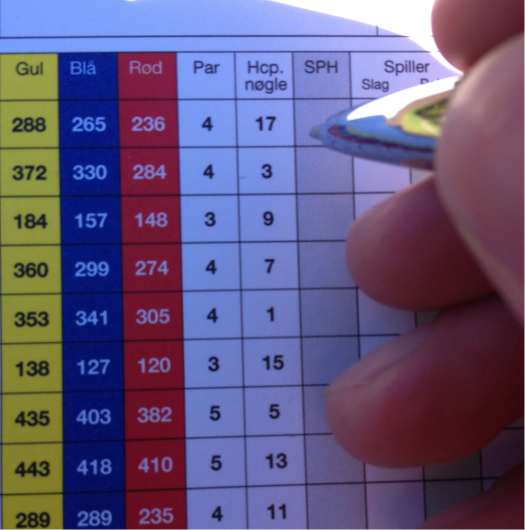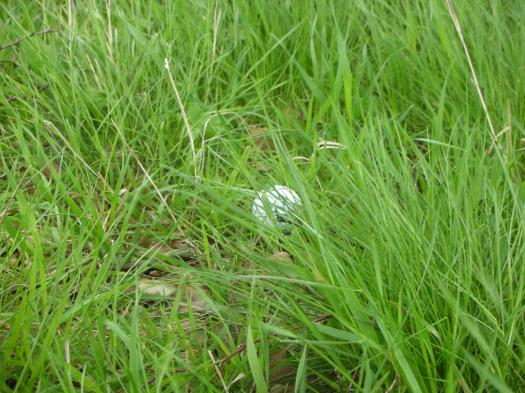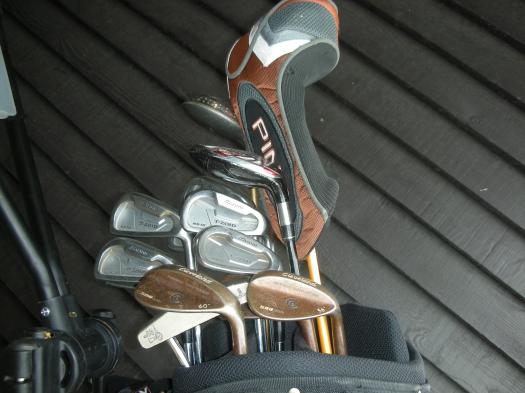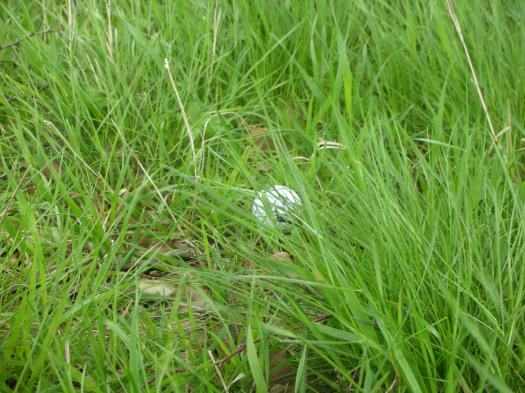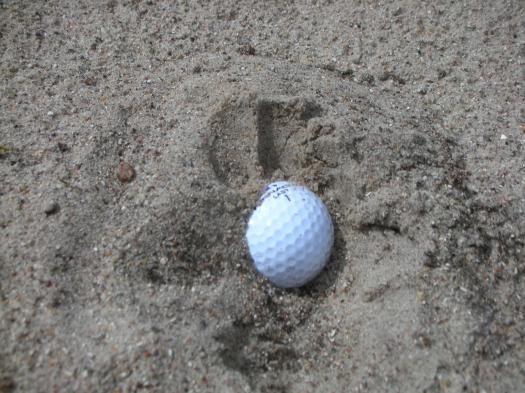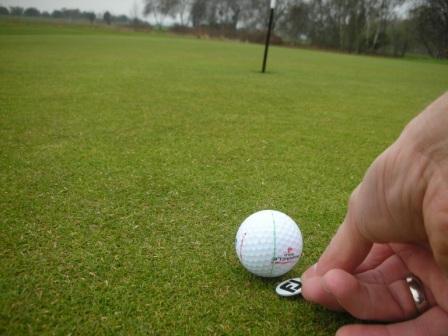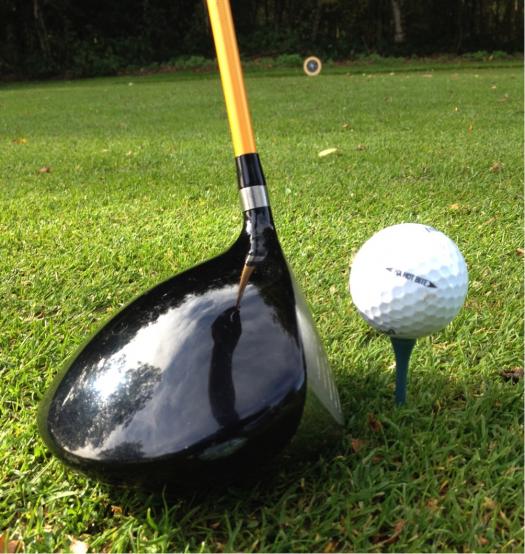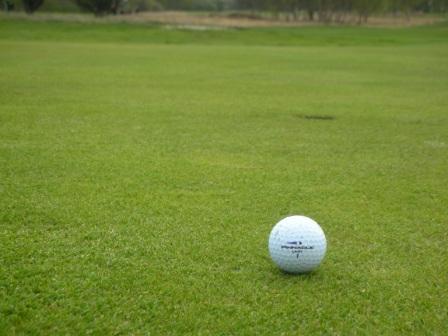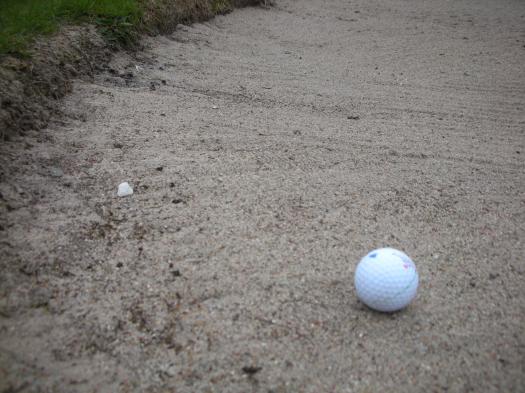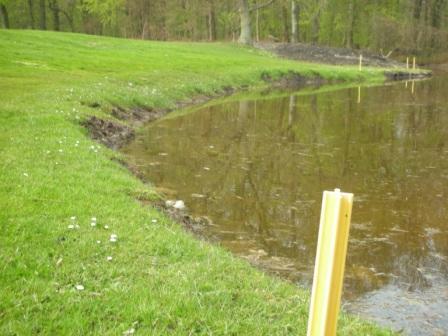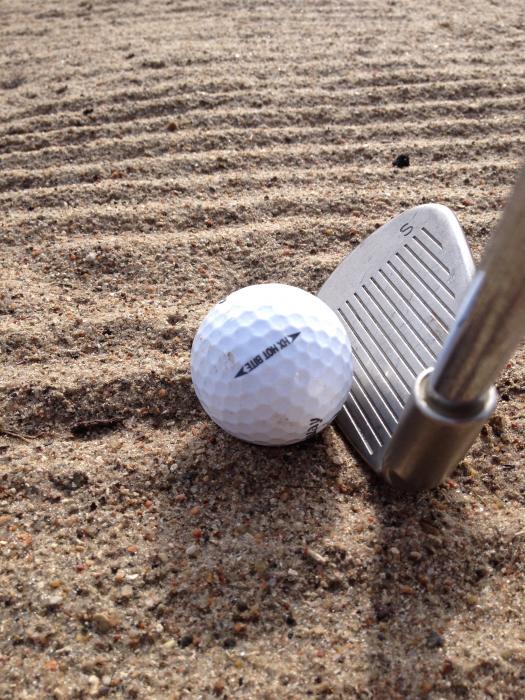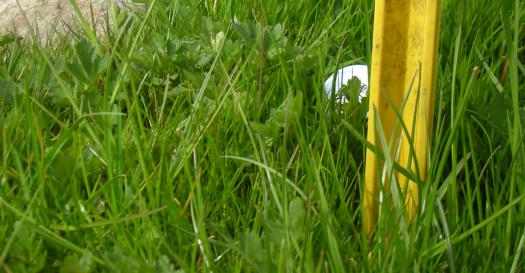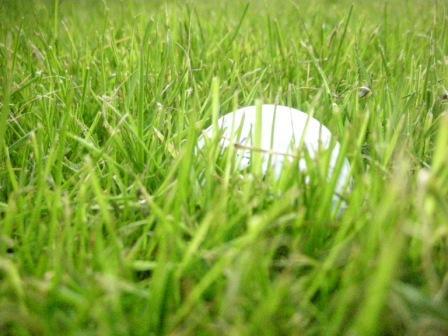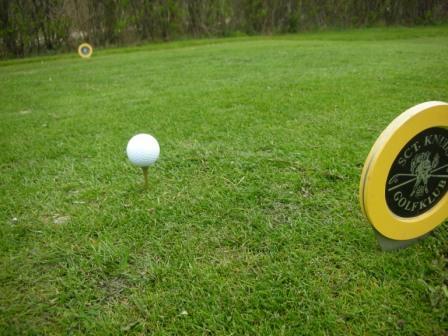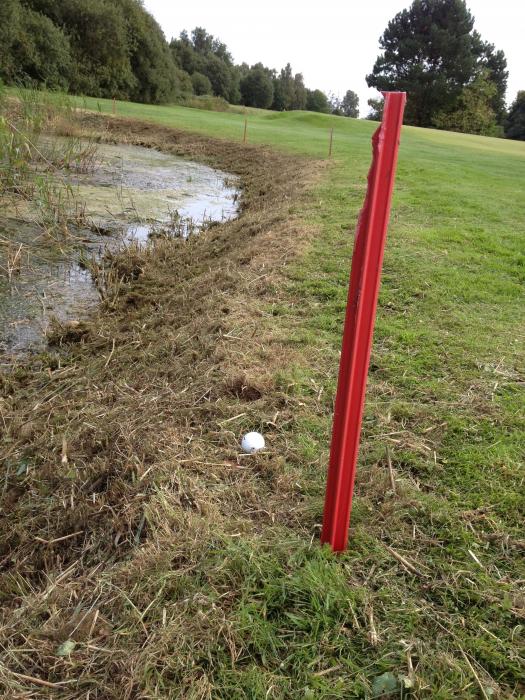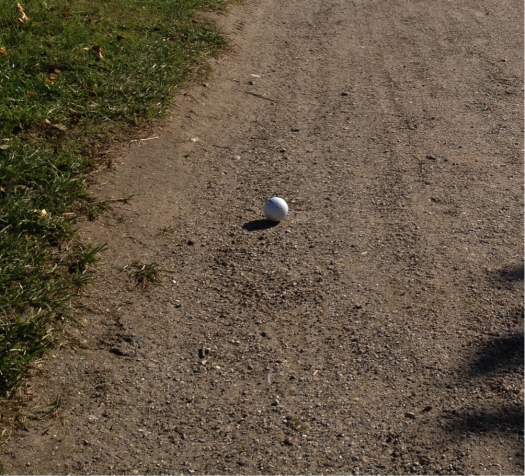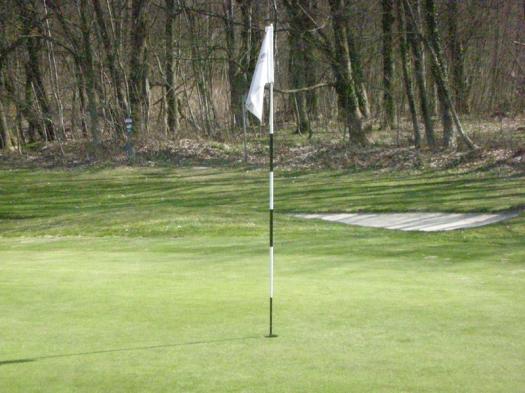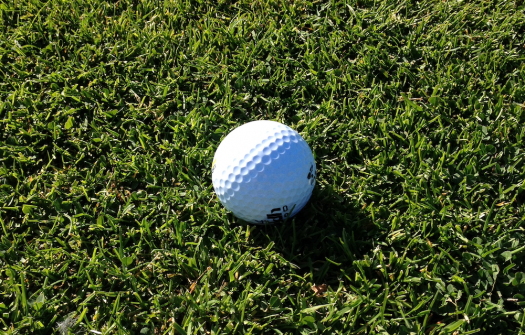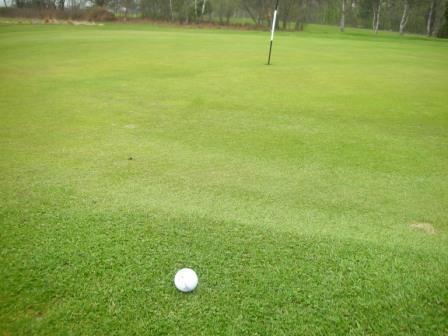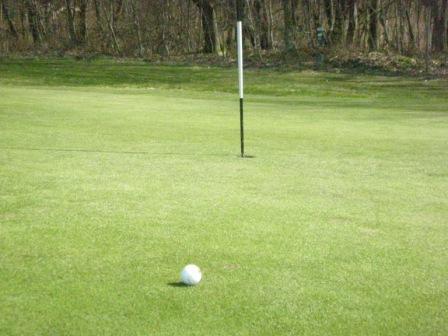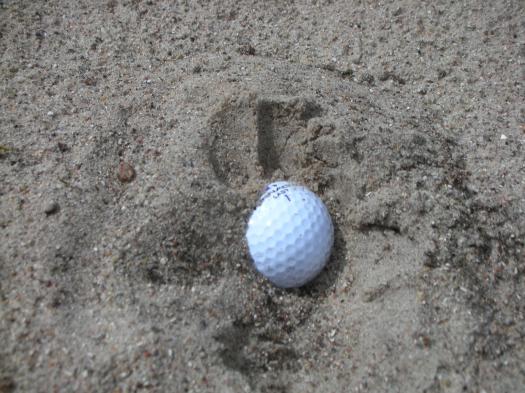Rules Exam For New Golfers
-
(#2) You mark and lift your ball on the putting green. Are you allowed to clean it?
-
Yes.
-
No.
-
Welcome to the Rules exam!
There are 18 questions, and you must get at least 12 correct to pass the exam.
If (when!) you pass, you can see the correct answers, and you can download/print your diploma.
NB: Before (not after) each question in the summary after the exam, you can see if you answered the question correct or wrong.
Best of luck!
OSWALD ACADEMY
Brian Nygaard Oswald
Founder - www. Golfrules. Com - bno@golfrules. Com

Quiz Preview
- 2.
(#8) Your ball is on the putting green two feet from the hole. The other player says that the flagstick must be in the hole, when you are putting. You, on the contrary, are sure that you are allowed to putt without the flagstick being in the hole. Who is correct?
-
You are.
-
The other player is.
Correct Answer
A. You are. -
- 3.
(#19) What is the maximum number of clubs you are allowed to bring?
-
10.
-
14.
-
20.
-
There is no maximum.
Correct Answer
A. 14. -
- 4.
(#40) Is the teeing area the only area on the course, where you are allowed to tee your ball?
-
Yes.
-
No.
Correct Answer
A. Yes. -
- 5.
(#14) Your ball is lying on the putting green. Before putting you would like to repair two pitch-marks in your line of play on the putting green. Is that allowed?
-
Yes.
-
No, you would incur one penalty stroke for improving your line of play.
-
No, you would incur two penalty strokes in stroke play (loss of hole in match play) for improving your line of play.
Correct Answer
A. Yes. -
- 6.
(#13) You mark and lift your ball on the putting green. You are considering substituting your ball with another ball and then putt with that other ball (there is nothing wrong with your ball – you simply just want to putt with the other ball – it is your favorite putting-ball!) Would that be OK?
-
Yes.
-
No.
Correct Answer
A. No. -
- 7.
(#3) You make your first stroke from the teeing area on a par-3 hole. It is a great shot – the ball ends on the putting green. You approach the ball and when you are approximately three feet before it, it begins to roll… and it rolls and rolls…and comes to rest outside the putting green! You are not sure what caused the ball to move – maybe it was the wind, maybe the slope or maybe your movement close to the ball. What now?
-
The ball must be replaced without penalty.
-
The ball must be replaced with a one stroke penalty.
-
The ball must be played as it lies without penalty.
-
The ball must be played as it lies with a one stroke penalty.
Correct Answer
A. The ball must be played as it lies without penalty. -
- 8.
(#41) You play from the teeing area, but since you are so very nervous, you don’t strike the ball, although it was your intention (a “whiff”). Does this whiff count as a stroke?
-
Yes.
-
No, to make a stroke you must strike the ball.
Correct Answer
A. Yes. -
- 9.
(#43) Your ball lies in temporary water in the semi-rough. Are you allowed to take relief without penalty?
-
Yes.
-
No, you are only allowed to do that in a “General Area” cut to fairway height or lower (e.g. on the fairway).
Correct Answer
A. Yes. -
- 10.
(#7) The ball must be dropped from what height?
-
You must drop from no higher than knee height (thus, under knee height is OK).
-
You must drop from at least knee height (thus, over knee height is OK).
-
You must drop from knee height (not over and not under).
Correct Answer
A. You must drop from knee height (not over and not under). -
- 11.
(#21) Exactly how long is one ”club-length”?
-
The length of your putter.
-
The length of the club you in each case use to measure with.
-
The length of the longest club you have brought, except a putter.
-
80 inches.
Correct Answer
A. The length of the longest club you have brought, except a putter. -
- 12.
(#39) You accidentally move your ball in play in the rough during search for it. It must be replaced… but did you incur any penalty?
-
No.
-
Yes, one penalty stroke.
-
Yes, two penalty strokes in stroke play (lost hole in match play).
Correct Answer
A. No. -
- 13.
(#17) Your ball lies on the putting green 30 feet from the hole. The other player’s ball lies in a bunker 15 feet from the hole. Both of you are ready to play. Who should play first?
-
You should (your ball is farthest from the hole).
-
The other player should (all balls must be on the putting green before anyone begins putting).
Correct Answer
A. You should (your ball is farthest from the hole). -
- 14.
(#5) Your ball lies in the rough. You accidentally strike the ball twice in the stroke (a “double-hit”). What now?
-
You have made two strokes and incur a one stroke penalty.
-
You have made two strokes and incur no penalty.
-
You have made one stroke and incur a one stroke penalty.
-
You have made one stroke and incur no penalty.
Correct Answer
A. You have made one stroke and incur no penalty. -
- 15.
(#10) You putt from the putting green with the flagstick left in the hole. The ball comes to rest leaning against the flagstick (due to windy conditions the flagstick is not standing straight in the hole). Most of the ball is above the surface of the putting green but approximately 1/5 of the ball is below the surface. Is the ball holed?
-
Yes.
-
No (to be holed, all the ball must be under the surface).
Correct Answer
A. Yes. -
- 16.
(#36) Your ball is in a penalty area. Are you allowed to remove some loose leaves from the penalty area before the stroke?
-
Yes.
-
No.
Correct Answer
A. Yes. -
- 17.
(#20) Your 7-iron is bent, when you strike your ball very close to a tree. Are you allowed to use this 7-iron during the rest of the round?
-
Yes.
-
No.
Correct Answer
A. Yes. -
- 18.
(#23) Are you allowed to use a club to mark your ball on the putting green with, before you lift the ball?
-
Yes.
-
No, you must use a ball-marker (see picture).
Correct Answer
A. Yes. -
- 19.
(#28) Your stroke from the teeing area is poor, and the ball heads towards some rough. You don’t play a provisional ball. You don’t want to search, but instead you walk directly to the fairway and drop a ball with two penalty strokes in accordance with the Local Rule in place (alternative to stroke-and-distance for a ball out of bounds/ ball not found). Is that OK?
-
Yes.
-
No. Before being allowed to apply the Local Rule you must search for three minutes.
Correct Answer
A. Yes. -
- 20.
(#30) Your ball lies on the putting green. You make a practice swing too close to the ball, whereby you accidentally strike and move it. What now?
-
You have made a stroke (play the ball as it lies). You don’t incur any penalty.
-
You have made a stroke (play the ball as it lies). You incur a one stroke penalty.
-
You have not made a stroke (replace the ball). You don’t incur any penalty.
-
You have not made a stroke (replace the ball). You incur a one stroke penalty.
Correct Answer
A. You have not made a stroke (replace the ball). You don’t incur any penalty. -
- 21.
(#25) You make a stroke from the teeing area, and the ball goes towards out of bounds. You play a provisional ball, which ends in some rough (in bounds). You walk towards the two balls, and realize within seconds that the first ball indeed is out of bounds, and that the provisional ball lies really bad in the rough. You don’t want to play the provisional ball (due to the bad lie), but instead you would prefer to drop a ball on the fairway in accordance with the Local Rule in place (alternative to stroke-and-distance for a ball out of bounds/ ball not found). Would that be OK?
-
Yes, with a two stroke penalty.
-
Yes, with a one stroke penalty.
-
No.
Correct Answer
A. No. -
- 22.
(#32) Your ball lies on the fairway, but you cannot play towards the putting green because the group in front of you has not finished the hole. To pass time, you place a ball on the fairway and make several practice strokes. Are you allowed to do that?
-
Yes, it is perfectly OK.
-
No, you incur one penalty stroke for making practice strokes.
-
No, you incur two penalty strokes in stroke play (loss of hole in match play) for making practice strokes.
Correct Answer
A. No, you incur two penalty strokes in stroke play (loss of hole in match play) for making practice strokes. -
- 23.
(#22) Are you allowed to remove loose impediments from a bunker and/or from a penalty area, when the ball is lying in the bunker/penalty area?
-
No.
-
Yes from bunkers, but not from penalty areas.
-
Yes from penalty areas, but not from bunkers.
-
Yes.
Correct Answer
A. Yes. -
- 24.
(#33) Your score at hole 8 was 5 strokes, but the other player you played with scored 6. The other player (having a much higher handicap than you) got three Stableford points, though, and you only got two points. Who should play first (who has the honour) at hole 9 (both of you are ready)?
-
You.
-
The other player.
Correct Answer
A. You. -
- 25.
(#37) You make your first stroke from the teeing area and the ball heads towards some rough. You do not play a provisional ball. Within 30 seconds after beginning your search you find your ball in the rough (in bounds). You decide to drop on the fairway since there is a Local Rule in place (alternative to stroke-and-distance for a ball out of bounds/ ball not found). Are you allowed to do so?
-
Yes, with two penalty strokes.
-
Yes, with a one stroke penalty.
-
No.
Correct Answer
A. No. -
- 26.
(#29) The player you are playing with is about to play from the teeing area on a par-3 hole. She has chosen to play a 7-iron for the 125-yard hole. Before making the stroke, you tell her, that it would be wiser for her to take a 6-iron, since it is more uphill than it looks like. She appreciates this information. Do you incur any penalty for this help?
-
No, it is completely OK to help each other this way.
-
Yes, you incur one penalty stroke for giving advice.
-
Yes, you incur two penalty strokes in stroke play (lost hole in match play) for giving advice.
Correct Answer
A. Yes, you incur two penalty strokes in stroke play (lost hole in match play) for giving advice. -
- 27.
(#38) You strike your ball towards some bushes and therefore play a provisional ball. After having searched for the first ball for 10 seconds you announce: “I declare it lost!” and then walk forward to play the provisional ball in the fairway. 20 seconds after this announcement – and before having played the provisional ball – the other players find your first ball in the rough! Which of the two balls are you going to play?
-
You must play the first ball.
-
You must play the ”provisional” ball (which became the ball in play when you declared the first ball lost).
Correct Answer
A. You must play the first ball. -
- 28.
(#4) Your ball lies badly in a bunker. Are you allowed to proceed under the unplayable ball Rule and drop a ball outside the bunker using the “back-on-the-line” relief option?
-
No, you must drop in the bunker!
-
Yes, with a one stroke penalty.
-
Yes, with a two stroke penalty.
-
Yes, with a three stroke penalty.
Correct Answer
A. Yes, with a two stroke penalty. -
- 29.
(#24) Are you allowed to mark your ball on the putting by placing the ball-marker/club right in front of the ball.
-
Yes.
-
No, it must be placed right behind the ball (see picture).
Correct Answer
A. Yes. -
- 30.
(#42) You play from the teeing area (stroke play), but immediately afterwards you realize that you have played from the teeing area of hole 17 – you should have played from the teeing area of hole 14! What now?
-
The stroke counts (play it as it lies), and you incur two penalty strokes.
-
The stroke counts (play it as it lies), and you incur one penalty stroke.
-
The stroke does not count (play a ball from within the correct teeing area), but you incur two penalty strokes.
-
The stroke does not count (play a ball from within the correct teeing area), but you incur one penalty stroke.
Correct Answer
A. The stroke does not count (play a ball from within the correct teeing area), but you incur two penalty strokes. -
- 31.
(#34) Your ball is in a red penalty area. You would like to take relief with a one stroke penalty. How many options for relief do you have (your Club does not have any Local Rule in operation about that)?
-
Two.
-
Three.
-
Four.
Correct Answer
A. Three. -
- 32.
(#16) You play hole 14, and your ball ends on a double green (putting green for both hole 14 and for hole 3). Your ball lies on the part of the putting green, that belongs to hole 3. Are you allowed to play the ball as it lies?
-
Yes, always.
-
Yes, unless the double green has been divided into two separate greens (e.g. with a line) – in which case you must take relief without penalty.
-
No, you must take relief without penalty.
Correct Answer
A. Yes, unless the double green has been divided into two separate greens (e.g. with a line) – in which case you must take relief without penalty. -
- 33.
(#6) Your ball is in a bunker. Are you allowed to make a practice swing in the bunker whereby you touch the sand with the club?
-
Yes!
-
No, you incur a one stroke penalty.
-
No, you incur a two stroke penalty in stroke play (loss of hole in match play).
Correct Answer
A. No, you incur a two stroke penalty in stroke play (loss of hole in match play). -
- 34.
(#26) You make your first stroke from the teeing area, and the ball goes in the direction of a penalty area. Are you allowed to play a provisional ball (your Club does not have any Local Rule in place about provisional balls)?
-
Yes, always.
-
Yes, but only if the ball might be lost outside the penalty area (e.g. in some rough).
-
No, not when your stroke was heading towards a penalty area!
Correct Answer
A. Yes, but only if the ball might be lost outside the penalty area (e.g. in some rough). -
- 35.
(#45) Your ball lies in a bunker. Before the stroke you ground your club right behind the ball and thereby touches the sand. Is that allowed?
-
Yes.
-
No, you incurred one penalty stroke.
-
No, you incurred two penalty strokes (loss of hole in match play).
Correct Answer
A. No, you incurred two penalty strokes (loss of hole in match play). -
- 36.
What is the proper procedure if a golfer's ball comes to rest out of bounds?
-
The golfer must play the ball as it lies without penalty.
-
The golfer can move the ball back in bounds, taking a one-stroke penalty.
-
The golfer must take a drop within two club-lengths from where the ball crossed the boundary, incurring a one-stroke penalty.
-
The golfer must play a new ball from the original spot with a one-stroke penalty.
Correct Answer
A. The golfer must play a new ball from the original spot with a one-stroke penalty.Explanation
According to the rules of golf, if a ball is hit out of bounds, the player must take a stroke-and-distance penalty. This means the player incurs one penalty stroke and must hit another ball from as close as possible to the location from which the original ball was last played (Rule 18-2). This rule helps maintain the pace and integrity of the game.Rate this question:
-
- 37.
(#1) Your ball is embedded in its own pitch-mark in the rough (outside a penalty area). Are you allowed to take relief without penalty?
-
Yes, always.
-
Yes, unless a Local Rule states, that you are not.
-
No, you are only allowed to, when the ball is in a closely mown area.
Correct Answer
A. Yes, unless a Local Rule states, that you are not. -
- 38.
(#27) You decide to play a provisional ball and therefore make this announcement to the other players: “I’m going to play another just in case”. Is it a provisional ball?
-
Yes.
-
No, you must say the word “provisional”. Therefore, it is the ball in play.
Correct Answer
A. Yes. -
- 39.
(#35) Your ball is in a penalty area. Are you allowed to take unplayable-ball-relief with a one stroke penalty?
-
Yes.
-
Yes, but the penalty is two strokes, though.
-
No.
Correct Answer
A. No. -
- 40.
(#12) Your ball lies (in bounds) on a gravel-surfaced path. Are you allowed to take relief without penalty?
-
Yes, always.
-
Yes, but only if a Local Rules allows you to.
-
Yes, unless prohibited by Local Rule.
-
No.
Correct Answer
A. Yes, unless prohibited by Local Rule. -
- 41.
(#9) Before your putt from the putting green 20 feet from the hole, you remove the flagstick from the hole. You place it approximately 10 feet behind the hole. Your putt is way too long, though, and the ball therefore accidentally strikes the flagstick. Do you incur any penalty?
-
Yes, two penalty strokes in stroke play (loss of hole in match play).
-
Yes, one penalty stroke.
-
No, no penalty.
Correct Answer
A. No, no penalty. -
- 42.
(#31) Your ball lies on the fairway. You make a practice swing too close to the ball, whereby you accidentally strike and move it. What now?
-
You have made a stroke (play the ball as it lies). You don’t incur any penalty.
-
You have made a stroke (play the ball as it lies). You incur a one stroke penalty.
-
You have not made a stroke (replace the ball). You don’t incur any penalty.
-
You have not made a stroke (replace the ball). You incur a one stroke penalty.
Correct Answer
A. You have not made a stroke (replace the ball). You incur a one stroke penalty. -
- 43.
(#18) You are playing hole 17, but your ball ends on the fringe of the putting green at hole 2 (wrong green). The stance for your intended stroke is on the putting green of hole 2. Are you allowed to play the ball as it lies?
-
Yes (you must only take relief without penalty, if the ball lies on a wrong green).
-
No, you must take relief without penalty (unless a Local Rule states something else).
-
No, you must always take relief without penalty.
Correct Answer
A. No, you must take relief without penalty (unless a Local Rule states something else). -
- 44.
(#15) Your ball lies on the putting green 10 feet from the hole, and another players ball lies on the putting green 5 feet from the hole (on the other side of the hole). Your putt is really bad and thus your ball accidentally strikes and moves the other player’s ball! Do you incur any penalty?
-
Yes, two penalty strokes in stroke play (lost hole in match play).
-
Yes, two penalty strokes in stroke play (no penalty in match play).
-
Yes, one penalty stroke (both in stroke play and in match play).
-
No.
Correct Answer
A. Yes, two penalty strokes in stroke play (no penalty in match play). -
- 45.
In stroke play, what should a golfer do if they play a wrong ball during the round?
-
Continue playing the wrong ball with no penalty.
-
Replace the wrong ball and play the correct ball with a two-stroke penalty.
-
Incur a two-stroke penalty, then continue playing the correct ball from where the wrong ball was played.
-
Play the correct ball from its original location with no penalty.
Correct Answer
A. Incur a two-stroke penalty, then continue playing the correct ball from where the wrong ball was played.Explanation
According to the rules of golf, playing a wrong ball results in a two-stroke penalty in stroke play. After realizing the mistake, the player must correct the error by playing the correct ball from where the wrong ball was played. This ensures fairness and maintains the integrity of each player's score.Rate this question:
-
Quiz Review Timeline (Updated): +
Our quizzes are rigorously reviewed, monitored and continuously updated by our expert board to maintain accuracy, relevance, and timeliness.
-
Current Version
-
Jul 26, 2024Quiz Edited by
ProProfs Editorial Team -
Apr 21, 2019Quiz Created by
 Back to top
Back to top



